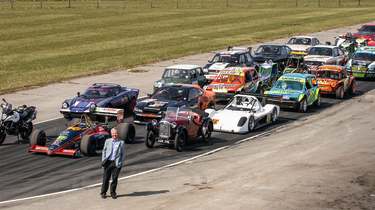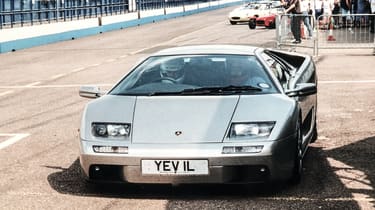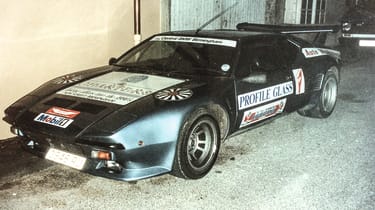My Life & Cars – Richard Usher, CEO, Great British Car Journey
From selling windscreens to building Blyton Park, Richard Usher shares the story of his truly unique career with cars
A list of the cars that Richard Usher owns would fill a fair chunk of this article. The 65 year old runs the Great British Car Journey, which tells the story of the British car industry, and its protagonists, through ordinary cars, the ones built in volume. There are currently around 150 cars in the collection and Usher owns ‘fewer than half of them’.
The car that sowed the idea of the museum was a wonderfully preserved, base-spec Austin Maestro, a car that managed to pull together a number of threads woven into Usher’s life. That was about ten years ago, when he was running Blyton Park, the circuit he’d created near Gainsborough in Lincolnshire.
> My Life & Cars – Ian Callum, designer and car collector
‘There was this dear old boy in the village who used to come up every day and he made the mistake of telling me about his Maestro,’ recalls Usher. To most people this would be a mildly interesting aside, but to Usher, who had been sales and marketing director of Auto Windscreens, it tripped a memory.
‘The Maestro was one of the first volume cars with a glued-in screen, which was a complete game changer; we had to completely reinvent the business around this new mode of fitting. And it got me thinking: when was the last time I saw a Maestro? It started this fascination with the industry. I did history at Oxford and the historian in me that had been latent for 40 years came back.’
Usher was born in 1957 and cars were a feature in his life from the start. ‘Dad was a terrific car enthusiast, drove my mother absolutely crackers.’ They were saving for a house when his father spent £100 on a vintage Bentley. ‘He continued to buy totally unsuitable cars for the rest of his life.’
The family business, in Birmingham, was originally jewellery but after the First World War switched to being an early motor factoring business called Electric Service. ‘In the late ’20s if you had a radio at home, chances are it was powered by a car battery. Electric Service did a sort of milk round, replacing flat batteries weekly. They were into car component distribution too.’
Usher didn’t get the car bug until he was 10 or 11. ‘I suddenly got terribly interested in cars. It sort of hit me like a religion. I remember the 1970 Formula 1 season very well because I was very into Lotus. I was on a school trip and knew it was Monza that weekend. I went to buy a Sunday paper and there was a headline: “Rindt death inquiry”. I literally didn’t speak to anybody for a week.’
Usher failed his driving test twice. ‘I was mortified. I think I was a bit too relaxed because I’d done 1000s of miles on L-plates: my History master was a terrible driver and whenever we went on a trip he’d ask me to drive.’ His first car was a Mini Clubman Estate and it prompted him to immediately join the Oxford University Motor Club, which he became secretary of. The Mini was soon replaced by a 1275 Sprite: ‘Terrible car, registration ROP 651G, so it was immediately nicknamed Ropey. On the A5, a front shock absorber pulled completely out of its mount and the front wheel folded under the car.’
An equally dreadful Jensen Healey money pit followed. Usher’s first decent car came a few years after leaving university, when he was working for the family business, which by that time was exclusively windscreens. ‘I somehow persuaded my older brother that I should have something Lotus. So I went to Castles at Leicester and bought DAC 55Y, a Talbot Lotus Sunbeam that was about a year old.
‘As part of the motor factors we’d inherited a windscreen company called Birmingham Safety Glass. The windscreen business didn’t really take off until the late ’60s, when motorways started to get built, then all of a sudden the phone started to ring constantly. They were all toughened glass back then, so if a stone hit your screen it shattered and ended up in your lap. You needed instant service.
‘The penny dropped and my older brother picked up this ball. We ended up having fitting centres all over the motorway network. We had about ten of our own but our main business was wholesaling windscreens in vast quantities to Auto Windscreens.’
Auto Windscreens got bought out and not long after, in ’89, the same PLC acquired Birmingham Safety Glass. Usher survived the merging of the two boards, making himself useful in marketing and PR, and in time became sales and marketing director of Auto Windscreens. He discovered that Brian Holmes, the company founder, was into motorsport and that the company had hospitality suites at the major UK circuits. It also sponsored some drivers, which Usher already had experience of.
‘In ’87 my brother was doing the Formula First championship,’ he recalls. ‘There were a lot of very big accidents that year and my brother had most of them, earning him the nickname Crusher Usher. The battle was between Ben Edwards, who was fully funded, and Eugene O’Brien. I’ve always been amused by the quirky, and Eugene’s race transporter was an old laundry van with “Lacy Linens” still on the side. The only way they could get the car in was for Eugene to sit in it whilst it was being transported, so this van would arrive and the car would roll out with Eugene in it from wherever it had travelled!
‘It was very obvious that he had some talent but absolutely no money. With about three or four races to go I gave him two Motor Glass stickers and said, “Stick these on the side of the car and I’ll give you 500 quid.” He nearly bit my hand off!’ O’Brien just missed out on the title.
A couple of years later, flush from having sold the business, Usher put a package together for O’Brien to race in Formula Vauxhall Lotus. ‘We turned up at the first race with a transit van, a trailer and a caravan… and parked next to Derek Bell Racing’s 40-foot artic with six Lotuses in for his son Justin and a load of pay drivers…’ Usher felt he’d bitten off too much, but O’Brien qualified on the front row and was in contention right through the season. ‘We would have won the championship if not for a mistake at the Grand Prix support round. We lost the championship by two points.’
Usher had always had a thing about Lamborghinis but discovered that even second-hand Countaches were £100k. ‘Even with my bad record of buying cars I didn’t want one for that sort of money, so I went to see Dick Puxty at Emilia Concessionaires at Silverstone and he sold me a brand new Pantera, built to my spec, for £42k. It was a fun car. I did 25,000 miles in it.’
In ’93, in his role at Auto Windscreens, Usher did a deal with Peugeot that got O’Brien into the BTCC. ‘It wasn’t much money, about £140k. Eugene had quite a good year, racing with Robb Gravett, but the next year they signed Patrick Watts, who was really good in saloon cars. Eugene had a really big shunt at the first round and his season never got going.’
Looking for corporate hospitality opportunities, Usher got Auto Windscreens onto a Callaway Corvette at Le Mans in ’95, the year when there were no prototypes, it rained a lot and the McLaren F1 won. O’Brien shared a car with Robin Donovan and Riccardo Augusta, the latter the playboy heir to the MV Augusta company, and they finished 11th. ‘It was great,’ remembers Usher. ‘We took a load of insurers and really big customers, stayed in a fantastic hotel and gave them dinner in the restaurant halfway down the straight.’
Through Mike O’Brien, Eugene’s older brother, Usher was introduced to Darren Manning, a young driver big on talent but short on backing. Usher helped him into F3: ‘Darren did well enough to get a Formula 3000 drive with Christian Horner. It wasn’t a huge amount because Darren was a pretty good driver and his Russian teammate brought plenty of oil money. The deal was a little convoluted though, because Christian’s uncle did a lot of work for our arch rival, Autoglass!
‘Darren had a couple of OK seasons and that sort of petered out, so Mike and I wondered what to do next when Rockingham came along. They’d launched this ASCAR thing and they were desperate to have some drivers with profile. So we did a very cheap deal and Darren did really well. He wasn’t frightened by the oval.’
At this time, Usher finally had himself a Lamborghini, a Diablo VT 6.0. ‘I had it for about ten years, did about 25,000 miles in it, like the Pantera. It was driven quite hard. I drove around the Rockingham oval after hours, got up to about 130mph and thought: “Hell, this is scary!”’
Then the American Champ Car series visited Rockingham and Darren got a drive to add some local driver interest. A clutch issue meant he started at the back, but he climbed through and at one point was leading. ‘After the race one of the team bosses, Derrick Walker, came up and said, “I don’t know who this Darren Manning is but I’ve got a wealthy Mexican driving my car next year and if you can find $150k I’ll run Darren in the second car.” We’d just sold Auto Windscreens to the RAC so I did the deal there and then, and that got us over to America.
> My Life & Cars – David Brodie, racer and BBR co-founder
‘Despite running a Reynard when the car to have was a Lola, Darren finished seventh and that really woke everyone up.’ Chip Ganassi tested him for IndyCar and he was signed alongside Scott Dixon. ‘At that point, I’m kinda pinching myself! It wasn’t a great couple of seasons; they had the Toyota engine when the Honda was the one and we thought, well, we’ve not made much but we’ve had a lot of fun.’
It wasn’t quite over, though. ‘Darren got a call: “That Manning? I always thought you were useful.” It was AJ Foyt!’ Manning joined Foyt’s IndyCar team for 2007. ‘He got some great finishes and no one who drove that car after him got comparable results, but that was the end of racing for me. That’s when I thought: let’s build a circuit so I can have some fun myself!’
Years earlier, Usher had got to know the Top Gear team through Auto Windscreens’ sponsoring of the Top Gear Live show. ‘They’d got planning permission to build a studio on Enstone airfield [in Oxfordshire] and I said if you build the studio, I’ll build the track.’ It would prove another steep learning curve. ‘The airfield is a rough old place. And it’s all a bit mixed up in terms of who owns what bits. And it’s right on the edge of a very pretty little village called Enstone.’
Usher spent a lot of time, effort and money trying to get planning consent before realising that it wasn’t going to happen, and looked at many other airfields before giving up on the idea. Then, somewhat randomly, he found himself at Blyton, helping judge a driving competition Auto Windscreens was sponsoring. Usher saw the potential.
‘The unusual thing about Blyton was that the Americans had laid asphalt after the war. If you’re only reinstating, rather than laying asphalt on concrete, that’s much easier. It also helped that there was this long history of ad hoc motorsport there – rallycross, grasstrack and the like – that the council allowed and the locals didn’t complain about.’ Usher did the deal, reinstated a very specific, circuit-shaped amount of asphalt and the track opened in 2011.
‘I always thought it was going to be a little sort of trackday place and we’d see the odd interesting car, but actually so many amazing cars ran there. We even had a Jochen Rindt car, Lotus 72 chassis number one. I sat in that and had a real goosebump moment.
‘I sold Blyton in 2017 because I’d had lots of fun and made a reasonable amount of money. And I’d got to 60 and thought: I love Derbyshire, I don’t really want to be trogging over to Lincolnshire any longer. Also, the Maestro had started this fascination with the motor industry and I sold the idea of Great British Car Journey to a lot of people I’ve known for a long time. Covid hasn’t been a great time to start stuff, so it hasn’t been easy, but we are fine.’
Usher’s current passion in cars aligns with the museum. His daily is a Rover 600: once common, now rare and really quite good, but the car he loves is the Austin Seven: ‘I find driving the Seven therapeutic because you have to concentrate. I never thought I would love a car with 16 horsepower but I do absolutely love it and I’m looking forward to driving it home tonight!’
This story was first featured in evo issue 302.







